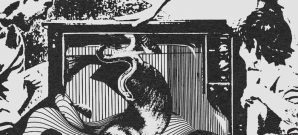 High Places vs. Mankind is High Places’ latest album of highly processed, otherworldly grooves. On the vanguard of sound design, High Places delivers a deep experience of far-out timbres, but falls short of reaching their full compositional potential.
High Places vs. Mankind is High Places’ latest album of highly processed, otherworldly grooves. On the vanguard of sound design, High Places delivers a deep experience of far-out timbres, but falls short of reaching their full compositional potential.
The album starts strong with the texturally jagged and striking "The Longest Shadows". This late-afternoon themed opener epitomizes the rest of the album with a catchy, sixteen bar bass line repeated underneath the ever-evolving loop-based accompaniment, meticulously designed by Rob Barber. The other key element is the echo-y vocals by singer Mary Pearson. Her posh, understated style is a distinctive element for High Places, but the words are generally very difficult to comprehend either because of the reverb, the EQ, or a combination of both. This first track, as well as most of the others, changes slowly and unremarkably without giving any strong sense of development. The result is an Eastern meditative quality throughout most of the album’s various soundscapes.
"On Giving Up" follows "The Longest Shadows", and it dances a similar straight 4/4 beat but with a bit of a heavier feel. Then, just as you’re wondering if the rest of the album will consist of the same basic rhythms sheathed in the covering of different, strange sounds, comes "She’s a Wild Horse", and, thankfully, a quite different kind of rhythm is introduced. The hollow, clay pot-sounding, Middle Eastern-influenced percussion and sitar-like guitar of "She’s a Wild Horse" backs up a story of a mysterious woman riding a white horse on an island. The song progresses, as the beat gets pumped up about halfway through and continues to intensify from there. "The Channon" exhibits the most creative use of sound design on the album as a metropolitan environment shifts into a mystical rainforest, but the track ends abruptly on a fade-out that totally invalidates any sound narrative that the listener may have thought was being conveyed. "Constant Winter" shows notable strength in melody, and the existential story of a young man who gets married and starts a family only to start the whole process over again is in keeping with the detached attitude of Mary Pearson’s vocal performance. A vibe-y mystery is achieved in "On a Hill in a Bed on a Road in a House" with one chanting vocal part and another singing over it.
The standout exception to the general rule of dispassionate displays of creative layering on this album is the final track "When It Comes". This song about death whose most striking lyric, "Put me down in the earth / Cover me up / Plant a tree on top so I can grow back up," speaks to a desire for immortality and oneness with nature. The melody and song-structure are far more developed in this than any of the other songs on the album, which makes it impactful. However, this track, like many of the others, ends carelessly with an uninspired termination of the loop elements. It is an abrupt and unsatisfying end to not only a song, but also the whole album.
High Places vs. Mankind consists of truly amazing loop constructions and a distinctive vocal sound, but the melodies, incomprehensible lyrics, and static harmonic character of most of the songs fails to create anything memorable or moving. The cutting-edge, atmosphere music created here may inspire other lovers of sound, but High Places’ legacy will remain limited unless the compositional aspect of their song-structure and lyrics is as highly developed as their layered sound rhythms and timbres.
MP3 Stream: "The Longest Shadows"



















